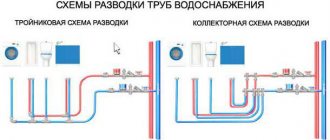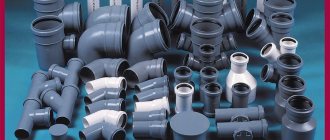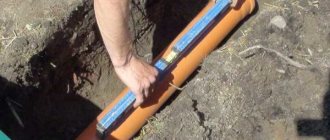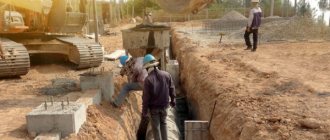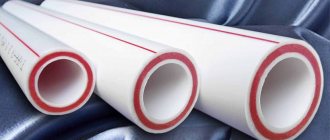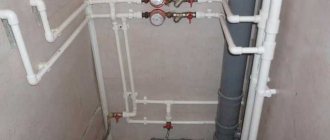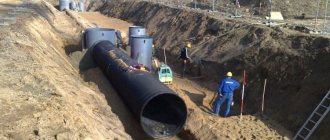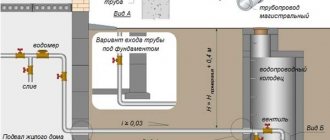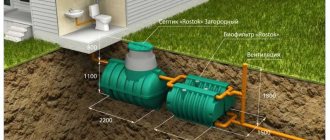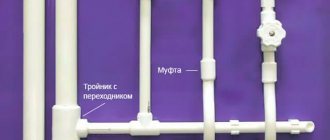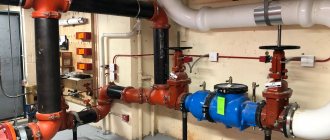Laying a water pipeline in the ground is an activity that in most cases is carried out with the organization of trenches (channels), however, there is also trenchless installation of water pipes. The advantage of organizing communications underground is that they are almost impossible to damage in this case. However, this method has many nuances that are worth paying attention to (for example, correct calculation of the laying depth).
For laying water supply, sewer and heating communications, an open or closed method is used.
Features of underground installation
Laying water lines or sewer communications underground is done everywhere. In the modern world, most apartment buildings and private buildings are connected to central highways. This allows us to eliminate the installation of local pumping equipment or the organization of boiler rooms.
To connect to the central water line, you need to lay a pipe from the house to it. And the question immediately arises: how to install a water pipe? If desired, you can mount the pipe on the surface of the earth (in an open way), however, this method entails a lot of problems.
When laying a pipe above ground, it is imperative to organize supports, as well as install the required amount of thermal insulation material, which is calculated based on the material of the pipeline itself and the climatic characteristics of the region. In addition, communication extended using this method is easier to damage. We should not forget about the aesthetic side of the issue, because a pipe crossing the yard looks unpresentable and can simply get in the way.
All of the above-mentioned difficulties of above-ground installation lead to the fact that many choose the second option for laying water pipes, namely underground. The installation of this communication is carried out in a certain order, in which the calculation of depth is important and should not be ignored in any case.
Underground pipe laying is complicated by calculations of trench depth related to the level of soil freezing
Important! As a rule, the soil freezing rate varies in different regions from 1.2 to 1.6 m. In order to protect the future pipeline from freezing, experts recommend laying it to a depth that exceeds the soil freezing rate in your region by 20 cm.
In addition to calculating the location of a water or sewer pipe in the ground, it is also necessary to take care of organizing thermal insulation. Moreover, communications laid using both trench and trenchless methods must be equipped with insulation.
Technical standards for buried systems
The laying depth is specified in special rules - SNiPs. All the nuances of working with products made from various materials are spelled out there. The minimum depth is one and a half meters. In general, this level depends on the depth of soil freezing. The pipeline must be deepened below the ground permafrost level. In regions with a cold climate, the pipeline will have to be buried deeper, otherwise it will deform under the influence of low temperatures.
The nuances of proper installation of a water supply system are described in a special document: “State elemental estimate standards for construction work” (GESN).
In the middle zone, water supply pipes need to be laid 1.6 meters from the surface, then they will not freeze and bend in winter during severe frosts.
Calculation of laying depth and selection of pipes
The laying of heating and water supply pipelines, as well as a sewer pipeline, is carried out, as mentioned above, to a certain depth. The pipes themselves are made from various materials, which differ from each other in quality characteristics, which also affects the laying features. A very important indicator for communications installed underground is strength. This is due to the fact that soil pressure acts on the pipeline.
It is easy to guess that metal pipes are the most resistant to soil loads. Let's look at what metals they are made from:
- steel (stainless and galvanized);
- cast iron;
- copper.
If the main line is located at great depth, then only metal pipes are used for its installation
However, the cost of metal products is quite high, so communications made of durable polymer compounds are often used. In addition, an important point is the marking, which is applied to the part during production. The marking must necessarily contain an indicator of the wall thickness of the product, which makes it possible to determine its strength. For example, sewer pipelines painted orange are allowed to be laid at a depth not exceeding 3 m, and products made of low-density polyethylene (HDPE) can withstand a pressure of 1.0 MPa, which is equal to 10 atmospheres. Such a pipe for laying sewerage can withstand high pressure levels. Accordingly, from such pipes not only a gravity sewer can be installed, but also a communication system equipped with pumping equipment.
There are certain standards, calculated in 1985, that indicate the dependence of the pipeline laying depth on climatic conditions. This pattern is shown in the table below.
Table 1
| Region | Pipeline laying depth, m |
| Southern regions | 0,85 |
| Central regions | 1,6 |
| Northern regions with severe climatic conditions | 2,75 |
This classification is approximate, so it is recommended to make the final calculation based on modern data for a specific region. In addition, the composition of the soil is also considered an important factor. The depth of laying water pipes or any other communications also depends on the composition of the soil. Fluctuations in freezing values for different soils are approximately 60 cm.
The type of pipes and the method of laying them also depends on the type of soil and climatic characteristics of the region.
Punching method and shield penetration technology
These technologies are also quite often used when it is necessary to assemble pipelines under obstacles. Laying a pipeline using the pushing method allows you to overcome obstacles up to one hundred meters long. In this case, the open end of the pipe is pressed into the ground. The earth plug that forms inside it is removed.
The tunneling shield consists of a support, knife and tail parts. The second ensures cutting off the rock and deepening the structure into the massif. The supporting part has the form of a ring and is designed to give the structure the necessary rigidity. The control panel is located in the rear section.
Factors to consider when calculating installation depth
As a rule, a pipe in the ground is affected by various destructive factors. These include:
- soil pressure;
- corrosion;
- stray currents.
These destructive factors must be taken into account when choosing material for future communication.
In addition to freezing, overheating of the pipeline structure, which can occur during the hot period of the year, is also undesirable. Let's consider the main factors on which the laying depth of a particular pipeline structure directly depends:
- temperature fluctuations in a particular region. Temperature indicators in summer and winter periods of the year;
- soil composition;
- vegetation in a specific area where the pipeline will be laid;
Note! The calculation results for each factor must be recorded with an accuracy of tenths.
- temperature of the working medium that will move along the pipeline line;
- the depth of water in the soil or its complete absence;
- the amount of precipitation falling in a specific region where the communication will be laid.
For proper installation of a pipeline structure in the soil, it is necessary to take into account each of the above factors. Today, thanks to the development of technology, their definition is not difficult.
Pipes laid underground sometimes require additional protection or insulation
Rules for carrying out work with hidden installation
Trenches for highways can be shallow or deep. In the first case, the pipeline is laid at a depth of 50-90 cm. When using the deep method, trenches are dug below the freezing point of the soil. An industrial pipeline can be laid at a depth of up to 5 m. The following rules are followed when laying pipelines:
- If the soil is dense, the pipes are laid directly on it.
- When laying at a depth of more than 4 m, or if the pipes are made of not very durable material, an artificial substrate is installed. The same is done if pipelines are assembled in difficult hydrogeological conditions.
- The bottom of the trenches is prepared in such a way that the pipes are in contact with it throughout. Existing voids are filled with local soil or sand.
- If there is groundwater in the lowest places, pits are installed to pump it out.
Laying water pipes underground: tips
After determining the depth of the communication, it is necessary to take into account several more important points and features of such a laying. Let's look at them:
- For water pipelines that transport hot water, metal-plastic or reinforced pipes are most suitable. Under no circumstances is it recommended to purchase polypropylene (PP) products for such purposes;
- organizing thermal insulation is a mandatory measure for both cold and hot pipes. This will maintain the correct temperature in the pipeline;
- when laying pipes in trenches, it is advisable to use permanent joints, since a monolithic structure in this case is the most correct solution;
- the soil cover in the area (which is often flooded) should not exceed 1 m;
- the main tap in the water supply line must be mounted in such a way that it is always freely accessible;
- Work on laying a water pipe underground can be done in two ways: trench and trenchless.
To understand the issue, it is recommended to study the specifics of both methods, since they are performed in different situations and differ in their characteristics and nuances.
Drawing up a water supply wiring diagram, what to consider?
The design of an apartment’s bathroom, drawn on a piece of paper by hand or drawn up by a professional, always takes into account not only the placement of plumbing fixtures, but also the methods of their connections, diagrams, methods of laying inlet and outlet branches. In this regard, regardless of whether you install communications yourself or hire third-party plumbers, you need to understand the fundamental points of piping assemblies.
What do plumbers call a point?
When calculating the cost of a job, misunderstandings often arise around this definition between the contractor and the customer. Therefore, using the wording “price per point”, find out what is included in it, and also estimate the total estimated cost of all work on the reconstruction of communications.
It is logical that a fixed price may be for some standard conditions for installing water supply in an average apartment. It will include the supply or drainage of water from the connection point of the plumbing fixture - an installed faucet for local use or a sewer inlet pipe in a bathroom or other room.
Note! Installation of the plumbing itself cannot be included in the cost of setting up the outlet. There is a big difference between the labor involved in connecting, for example, a washing machine and a hot tub. Therefore, payment for such operations is calculated separately, usually as a percentage of the price tag of the product.
Some equipment (washing machine or dishwasher) has only one recharge, being a single water point. If there are two supplies from cold (CW) and hot (HW) water (boiler, mixer), then this is a double point. Large lengths of pipe laying, complex or hidden wiring, and other special conditions additionally increase the cost of work, which is added to the price per point.
Trench method of laying water supply systems
The trench method is the most common and has been used since ancient times for organizing water lines and other utility communications. The essence of this method is that you need to dig a channel (of a certain depth) and lay a pipeline in it.
Underground pipe laying requires careful preparation of trenches
Using this method allows you to easily navigate and dig trenches laid in the right directions. Such work can be done even by one person manually. However, it is recommended to use special equipment in order to reduce labor costs and increase the speed of communication installation.
The depth of the trench, as mentioned above, is determined depending on the freezing point of the soil in a particular region. The trench width in the case of deep laying of communications, as a rule, ranges from 0.7 to 0.9 m. The width depends on the geometric dimensions of the pipeline, namely: cross-sectional indicator, wall thickness.
Helpful information! On the Internet you can easily find a table in which you will find the desired soil freezing indicator characteristic of your region.
Let's consider the procedure for trench laying water supply lines:
- The preliminary stage, which takes into account all the necessary preparatory work (purchase of material, calculations of the future pipeline, etc.).
- At the second stage, it is necessary to dig a trench, which must correspond to the calculations.
- Next, it is necessary to strengthen the bottom and walls of the trench. This action is carried out by compacting the soil.
- Then you need to make a sand cushion at the bottom of the trench. The thickness of the sand layer should be at least 10–15 cm.
- At the fourth stage, the pipeline is assembled in a trench.
- Next, you need to pour sand into the trench. There is one important rule here: the pipes are filled with sand to a level that is 5 cm higher than the highest point of communication.
- After this, it is necessary to lay a layer of tiles or bricks on the sand.
- Next, a very important point is to stretch out the red warning tape. It is necessary so that in the event of excavation work in this place, it can be determined from the tape that a water supply line passes here.
- We fill the channel with soil and compact it.
The trenchless method does not require extensive excavation and allows pipes to be laid much faster
Thus, trench laying of water and other pipes is carried out. By following the above rules, you can perform high-quality pipeline installation with your own hands.
Puncture gasket
Using this technology, main pipelines are pulled on loamy and clayey soils. When using it, it is possible to lay pipelines up to 60 m long. This technique consists of the following:
- a steel tip is put on the pipe;
- at a certain distance from the obstacle, dig a pit and install a hydraulic jack on supports into it;
- a pipe with a smaller diameter pipe inserted into it is lowered into the pit - a “ramrod”;
- The soil is punctured in stages.
When using this technique, the earth is not removed. During the puncture process, it is simply compacted around the circumference of the pipe.
Trenchless method of laying water supply systems
This method of organizing water supply in the ground, as well as sewerage, appeared not so long ago, but has already gained popularity. This is due to the fact that this method has several advantages over the trench method. Consider these benefits:
- low material consumption;
- minimal damage to the environment, since there is no need to dig a canal;
- reduction in cash costs (up to 30%);
- increasing the speed of work several times;
- minimal labor costs.
For trenchless installation of pipelines, special drilling rigs are used. There are two types of trenchless installation of pipeline communications:
- Sanitation.
- Puncture method.
Rehabilitation is a process that involves replacing an old pipe with a new one, or repairing it. In turn, the puncture method takes into account the introduction of a new pipeline into the ground. Let's look at the puncture method step by step:
- First, a puncture is made in the soil.
- Next, the resulting channel is fixed using a metal shell.
- At the third stage, the pipeline itself is pulled inside the metal channel. And the distance between the two pipes is sealed with heat-insulating material.
This method is also called a gasket in a case or in a casing. The organization of the protective casing allows you to significantly extend the operational life of the received communication, which is a definite plus.
External pipeline installation technology
May 13, 2021
The technology for installing external pipelines largely depends on their purpose and type of installation, pipe material, their diameter, wall thickness, length of pipes, the presence of ready-made insulation on them and its type (or lack thereof), as well as on the provision of construction with installation elements (pipe sections , whips) and other conditions.
Installation of pipelines from any types of pipes (or their sections) involves the need to connect them into a continuous thread. Pipelines on the route are assembled (mounted) from individual elements (pipes) of a relatively short length, and therefore a large number of joints have to be sealed or welded. This slows down and makes pipeline installation more expensive. The laying of pipelines is somewhat facilitated by preliminary enlargement of pipes into links or sections of two, three or more pipes.
Pipeline laying involves installing and assembling assembly units along the route - pipes (or their sections, strands), fittings, compensators and fittings - into the design position. Moreover, the larger the assembly unit, the fewer assembly joints and the easier the assembly of pipelines.
The units are assembled and tested, and also covered with a layer of insulation or painted at pipe procurement bases.
Industrial technology for laying pipelines provides for the centralized procurement of installation elements and assemblies, their delivery in finished form to the route, preliminary preparation of foundations and support structures for installation, and in-line assembly of pipelines.
The composition and sequence of work processes when laying pipelines depend on the type of pipes used (metallic and non-metallic), as well as on the conditions of their installation (in cramped urban or field conditions, on flat or rough terrain, in the presence or absence of natural or artificial barriers, etc.). P.).
Work when laying pipelines is usually carried out in several stages, performed sequentially: checking the quality of pipes; lowering pipes into the trench; centering and laying them in a given direction and slope, securing the pipes in place; sealing joints and checking their quality; testing and acceptance.
Checking the quality of pipes is usually carried out twice - at the manufacturer (according to an established method, sometimes with testing them on a bench) and directly on the route before laying them in a trench. On the route, almost all incoming pipes are subject to inspection and quality control. This is extremely necessary, because when installing a pipeline, especially a pressure one, using at least several or even one low-quality pipe will lead to ruptures and accidents at the place where they are laid.
It is very difficult to eliminate them, since this requires stopping the operation of the water pipeline and digging trenches. In case of accidents on water pipelines made of socketed cast iron or reinforced concrete pipes, replacing a low-quality pipe is very difficult. If in such cases it is impossible to correct the defects of a low-quality pipe in the trench, you have to destroy it (which is also not easy) and remove it, and in its place lay an “insert”, most often made of a steel pipe, since it is almost impossible to lay the same socket pipe.
If it is possible to correct the defect and put the pipeline into operation, then the “insert” will always be a weak point due to the rapid corrosion of the steel pipe.
On the route, incoming pipes are accepted according to documents (certificates, passports) of the manufacturing plants confirming their quality. However, defects may occur in pipes due to improper loading, transportation and unloading.
Therefore, before laying in a trench, pipes are carefully inspected, their actual quality is checked and rejected if serious and irreparable defects are detected. It is not allowed to lay pipes with cracks, chipped edges and sockets, large deviations from the circumference, i.e. with ovality and other serious defects.
The surface of rubber cuffs and rings used for making pipe joints must be smooth, without cracks, bubbles, foreign inclusions or defects that reduce their performance properties.
Technology for laying water supply pipelines
Laying a water pipeline in the ground is an activity that in most cases is carried out with the organization of trenches (channels), however, there is also trenchless installation of water pipes.
The advantage of organizing communications underground is that they are almost impossible to damage in this case.
However, this method has many nuances that are worth paying attention to (for example, correct calculation of the laying depth).
For laying water supply, sewer and heating communications, an open or closed method is used.
